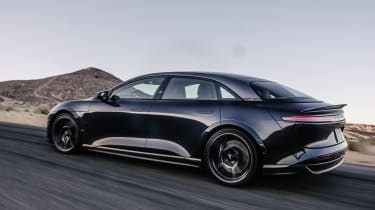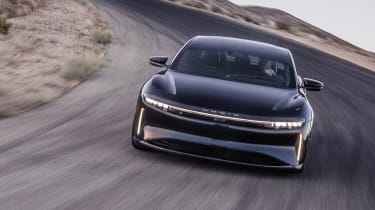New 2023 Lucid Air Sapphire review: 1200bhp supersaloon tested
Look beyond its 1200bhp-plus output if you can – this latest Air’s true torque‑vectoring capabilities give a tantalising taste of how EVs could become genuinely rewarding
I’m about to throw some very big numbers around. The sort that will make some of you very excited (hi kids!) and elicit eye rolls and mournful slow head shakes from the rest. However, before we get into the nitty-gritty of the Lucid Air Sapphire’s beyond ludicrous performance stats, I’d like to convey an inkling of the enthusiasm and love poured into this project. And demonstrate that it isn’t all about the numbers.
I’m at Willow Springs to experience the new performance flagship for the Air saloon in late prototype form. It’s an opportunity to meet the engineering team, understand the powerful torque-vectoring technology of this tri-motor EV and to try to determine if it’s worth the $249,000 asking price. For the team, it’s an opportunity to get an outsider’s opinion of the dynamic direction and to further hone the complex systems that make this 2380kg monster tick (I’m rolling the big numbers out slowly).
It’s their benchmark that I find fascinating as its gold rims sparkle in the early morning sunshine. David Lickfold, director of chassis and vehicle dynamics, and his team have chosen wisely. Lucid has bought a BMW M5 CS and it’s already cooling down after some hard laps of the track. Talk about shooting for the moon. ‘I continue to be amazed at how good it is,’ explains Lickfold. ‘At everything. It’s outrageous.’ We couldn’t agree more. The CS is truly a wonder of the motoring world. Whether the Sapphire can match its broad talents and forceful personality remains to be seen, but the very fact they recognise its brilliance is encouragement enough. They get it. Lucid wants to bring a similar level of excitement to the EV sector. God knows we need somebody to succeed in this mission.
More reviews
Standing on the throttle as the track opens up from the pitlane is certainly exciting. We’ve already driven the 1111bhp dual-motor Lucid Air (see evo 298) and its performance was anything but lacking. The Sapphire goes further still. Now fitted with a pair of electric motors on the rear axle, plus one on the front, power is simply stated as ‘over 1200bhp’. Lucid’s drive units are incredibly compact and unbelievably power dense. Comprising an electric motor, inverter and integrated transmission and differential, each unit weighs 74kg and produces up to 670bhp. You almost wonder why the Sapphire doesn’t have even more power. ‘Oh, we could do that,’ says one of the team. ‘But the batteries might not like it. Plus, this is probably fast enough.’
The Sapphire doesn’t hit you like a monstrously powerful ICE car. It’s more intense than that. There’s not quite the flick-switch power you expect, but instead it’s like being caught up and then carried relentlessly forward in a stampede. The sheer scale of the forces at work feels oddly elemental. It hardly seems to matter, but for the record Lucid claims 0-60mph in 1.89sec, 0-100mph in sub-4sec and the quarter-mile in less than 10sec at something approaching 160mph. The acceleration alone leaves me feeling queasy for the next 12 hours or so. It obliterates an M5 CS, of course. Or a Ferrari SF90 come to that.
More interesting is the radical shift in philosophy compared to the other models in the Air line-up. These prioritise range and comfort, which creates a unique dynamic identity. On the one hand the fitment of modest tyres and a focus on a fluid, easy-going balance with an unfashionable amount of pitch, roll and dive goes some way towards recreating an enthusiast’s imagined past. Most Airs don’t have massively high limits and they deliberately tread a different path to the ultra-flat and stable platforms of cars like the Porsche Taycan. So you can use weight transfer to dictate the balance, play with the car’s mid-corner attitude on the throttle and four-wheel drift around until your heart’s content. However, appealing as this sounds, with so much power and weight the Air can feel playful one minute and worryingly at the mercy of sheer momentum the next.
The Sapphire is more conventional in terms of suspension tuning – stiffer, more controlled and with more mechanical grip – but has another tool to exploit that is powerful, novel and compelling: true torque vectoring. Not a nip of the brakes here, or a clutch-based rear differential to divert power side-to-side, but absolute control of each rear wheel via its own motor. The options when you have this are tantalising – dramatic slowing of the inside rear to rotate the car; accelerating the outside wheel to make the most of the newfound agility; changing that strategy at high speeds to give huge confidence and stability. It’s been the promised land for some time in the EV world but rarely can you truly feel its benefits. The Sapphire puts this technology right at its centre.
It’s a new dimension that’s layered on top of some significantly revised hardware. For example, new front and rear wings stretch over wider tracks, the Sapphire rides lower and spring and damper rates for the Bilstein suspension are considerably increased. There are subtle but effective aero tweaks to create a bit of positive downforce, plus carbon-ceramic brakes supplied by Akebono and featuring ten-piston calipers. Bespoke Michelin Pilot Sport 4 S tyres with a near Cup 2-spec compound on the outer section are another trick ingredient to create a platform with real potential and one well equipped to deliver on the promise of the torque-vectoring capability.
‘We’ve been tuning the chassis and the algorithms to give what is almost a 3-metre-wheelbase car really good agility and balance at low speed, but a big priority has also been high-speed stability,’ explains John Culliton, senior technical specialist for chassis and vehicle dynamics. ‘But we wanted it to be seamless – totally intuitive.’
Perhaps, with time, it is. My initial impression is slightly different. I love the Sapphire’s new-found body control, the massively more resilient front end and the grittier, locked-down, keyed-in feel. With lesser Airs you’re managing the car’s performance and balancing it against the relatively modest grip. It’s entertaining but can become frustrating. The big saloon can slip too easily into understeer and the power on offer is just a little too out of kilter with the chassis limits. Now, it feels much more joined up. You can attack and feel the car accept the lateral loading. The brakes have reassuring power and subconsciously let you know there’s plenty of grip to lean into. It’s a freer experience and presents more options for the driver. On track the car’s natural responses are so different to the Air GT model also on hand ($138,000, 1050bhp) you’d hardly believe they were the same car.
Yet there is something new here, too. The torque-vectoring is tangible and intriguing. In slower turns it quickly chases understeer away with aggressive over-speeding of the rear axle; through quick turns you can feel it tweaking and cajoling the balance and holding the car in the perfect yaw angle. Sometimes this feels a little unnatural and the car reacts counter to expectations, but with more seat time I think you’d start to reprogram your own algorithms to understand and appreciate the alert agility and spookily flat, stable high-speed balance. Many great cars challenge you to adapt to their peculiarities – the Porsche 911 most notably but also cars such as the Mitsubishi Evo and Nissan GT-R – and I think as EV architecture starts to exploit the possibilities of independently controlled wheels we’ll need to embrace new techniques, too.
Today we’ve experienced one facet of the Lucid Air Sapphire’s capability. Its three drive modes – Smooth, Swift and the most aggressive Sapphire setting – offer a broad operating window and it’ll be really interesting to see how the vast possibilities of this mechanical layout can create a car with multiple personalities. But, on track at least, it’s a deeply impressive first taste. There’s still work to do on the transition between regen and friction brakes, there’s no way to fully disguise the car’s mass, and 1200-plus bhp is a real challenge even for the uprated chassis when the stability control is removed. But there’s no question this EV has personality. From the elegant, retro-futuristic look, to the coolly understated interior, wild performance and that complex, fascinating torque-vectoring capability, the Lucid Air Sapphire treads its own path. If we’re to really discover joy and a deep-rooted connection with the next generation of EVs, we need more manufacturers to exhibit this bravery.




